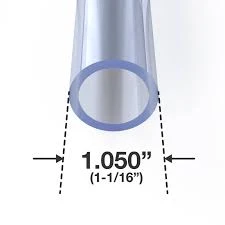Sep . 29, 2024 02:10 Back to list
Understanding the Benefits and Applications of PVC-O Pipe in Modern Construction
The Advantages of PVC-O Pipes
PVC-O (Oriented Polyvinyl Chloride) pipes have emerged as a revolutionary solution in the field of piping systems. Known for their outstanding strength, durability, and adaptability, these pipes are increasingly being utilized across various applications, from water distribution to industrial operations.
One of the primary advantages of PVC-O pipes is their enhanced mechanical properties. The orientation process during manufacturing results in a more robust molecular structure, allowing these pipes to withstand higher pressures compared to traditional PVC pipes. This property makes them ideal for water supply systems where the pressure is a critical factor. The improved strength helps reduce the risk of leaks and bursts, ensuring a reliable supply of water.
The Advantages of PVC-O Pipes
Moreover, PVC-O pipes exhibit excellent resistance to chemical corrosion, which is particularly advantageous for applications involving aggressive substances. Unlike metal pipes that may corrode over time, PVC-O pipes maintain their integrity, ensuring long-term functionality without compromising the quality of the transported fluids.
pvc-o pipe

Sustainability is also a crucial aspect of PVC-O pipes. Made from recyclable materials, these pipes contribute to environmental conservation efforts. The production process of PVC-O has lower energy consumption compared to other piping materials, reducing its carbon footprint. Furthermore, their long lifespan means that fewer resources need to be used for replacements, making them an eco-friendly option.
In terms of hydraulic performance, PVC-O pipes offer a smooth interior surface that minimizes friction loss. This feature enhances the flow rate, leading to more efficient water distribution systems. The combination of enhanced flow capacity and reduced energy costs makes PVC-O an attractive choice for municipalities and industries seeking to optimize their infrastructure.
Additionally, the versatility of PVC-O pipes allows them to be used in a variety of applications, from urban water supply networks to agricultural irrigation systems. Their adaptability to different environmental conditions further highlights their reliability and effectiveness in diverse settings.
In conclusion, PVC-O pipes represent a significant advancement in piping technology. With their superior strength, lightweight nature, chemical resistance, sustainable production, aerodynamic performance, and versatility, they offer a compelling alternative to traditional piping solutions. As industries continue to seek efficient and sustainable materials, the adoption of PVC-O pipes is likely to grow, paving the way for improved infrastructure worldwide.
-
High-Quality PPR Pipes and Fittings Durable ERA PPR & PVC PPR Solutions
NewsJul.08,2025
-
Black HDPE Cutting Board - Durable, Non-Porous & Food Safe HDPE Plastic Cutting Board
NewsJul.08,2025
-
High-Quality CPVC Panel Durable HDPE & PVC Panels Supplier
NewsJul.08,2025
-
Double PE Welding Rod Supplier - High Strength, Durable & Versatile Welding Solutions
NewsJul.07,2025
-
High-Quality PVC-O Pipe Supplier Durable 75mm PVC Pipe & Connections Leading PVC Pipe Company
NewsJul.07,2025
-
HDPE Drainage Pipe Supplier – Durable & Corrosion-Resistant Solutions
NewsJul.06,2025

